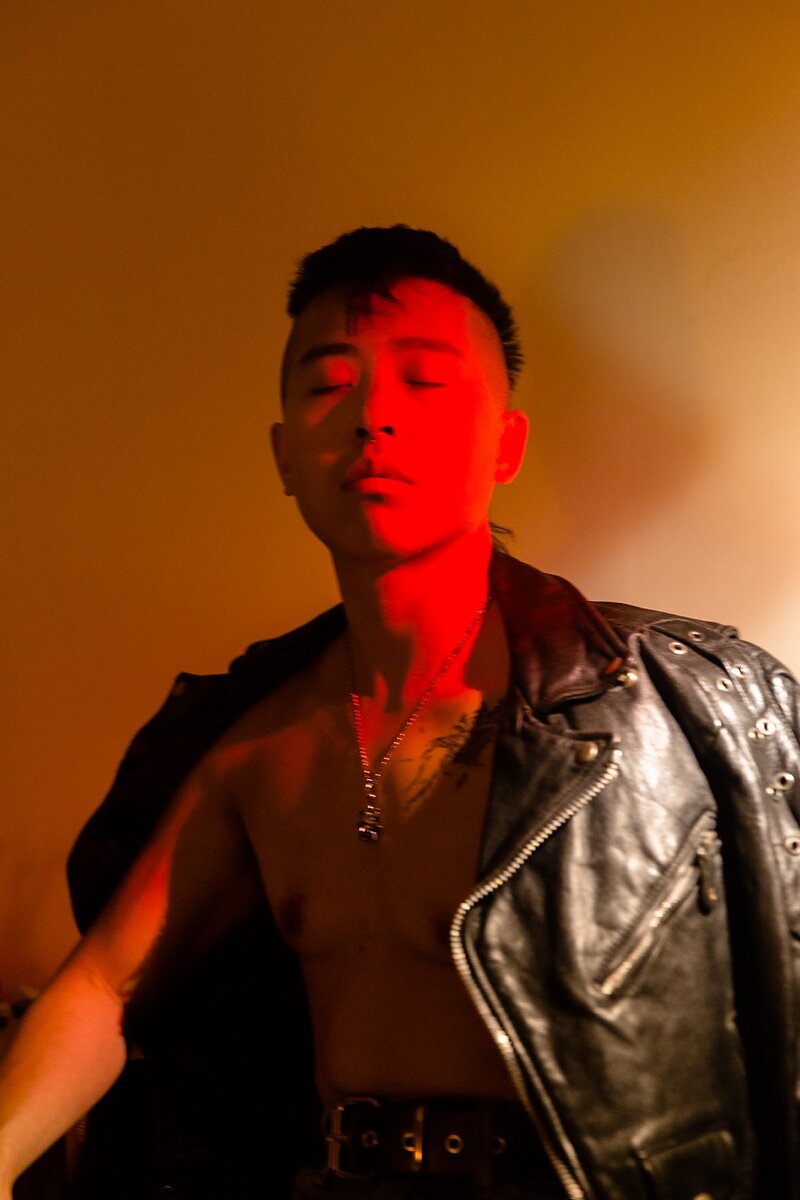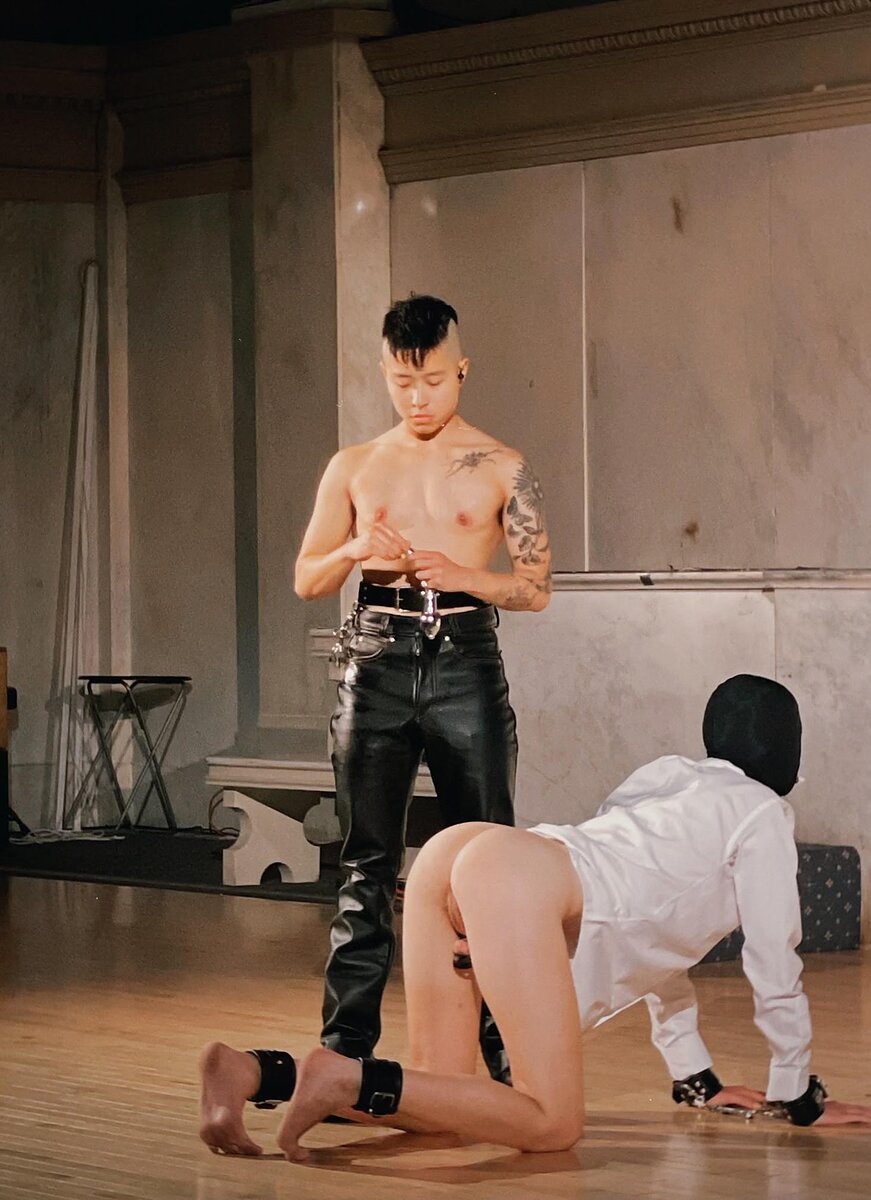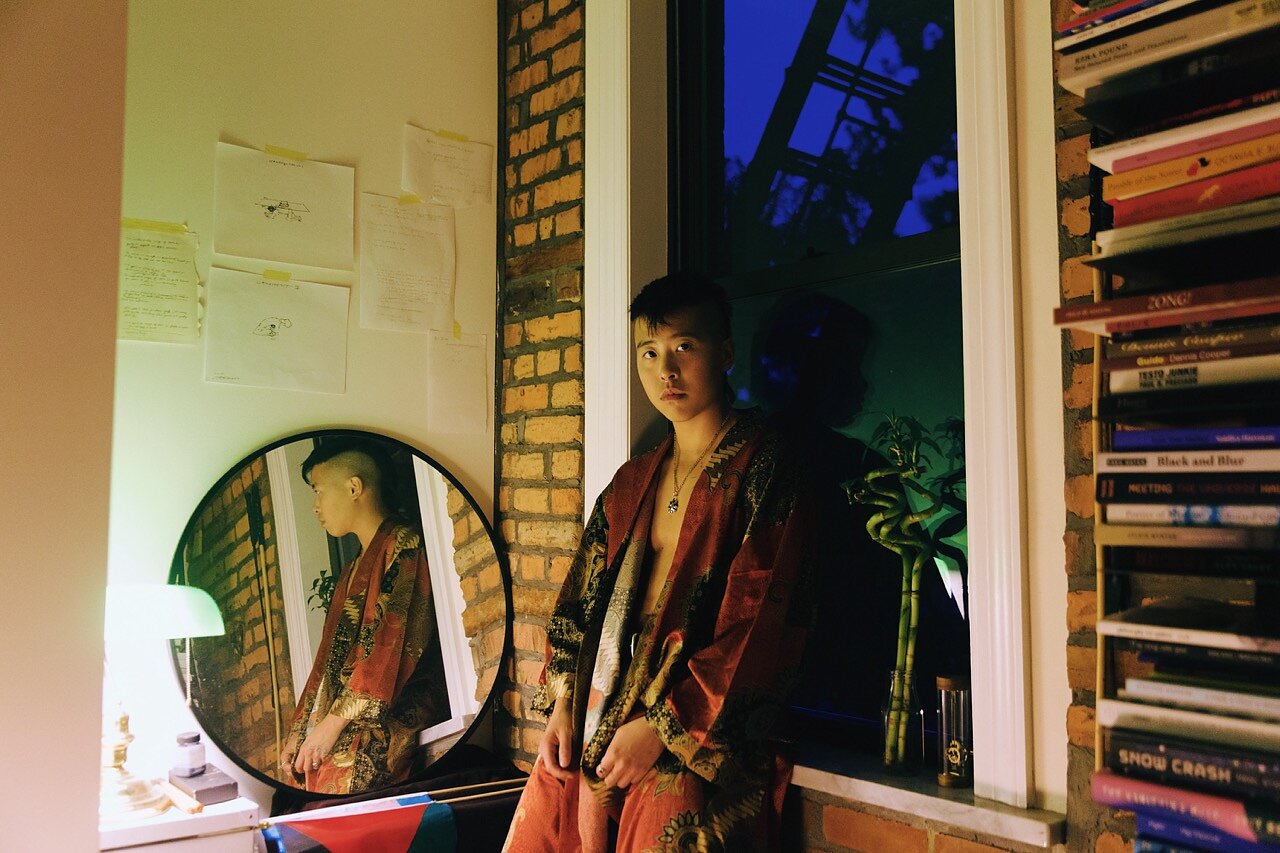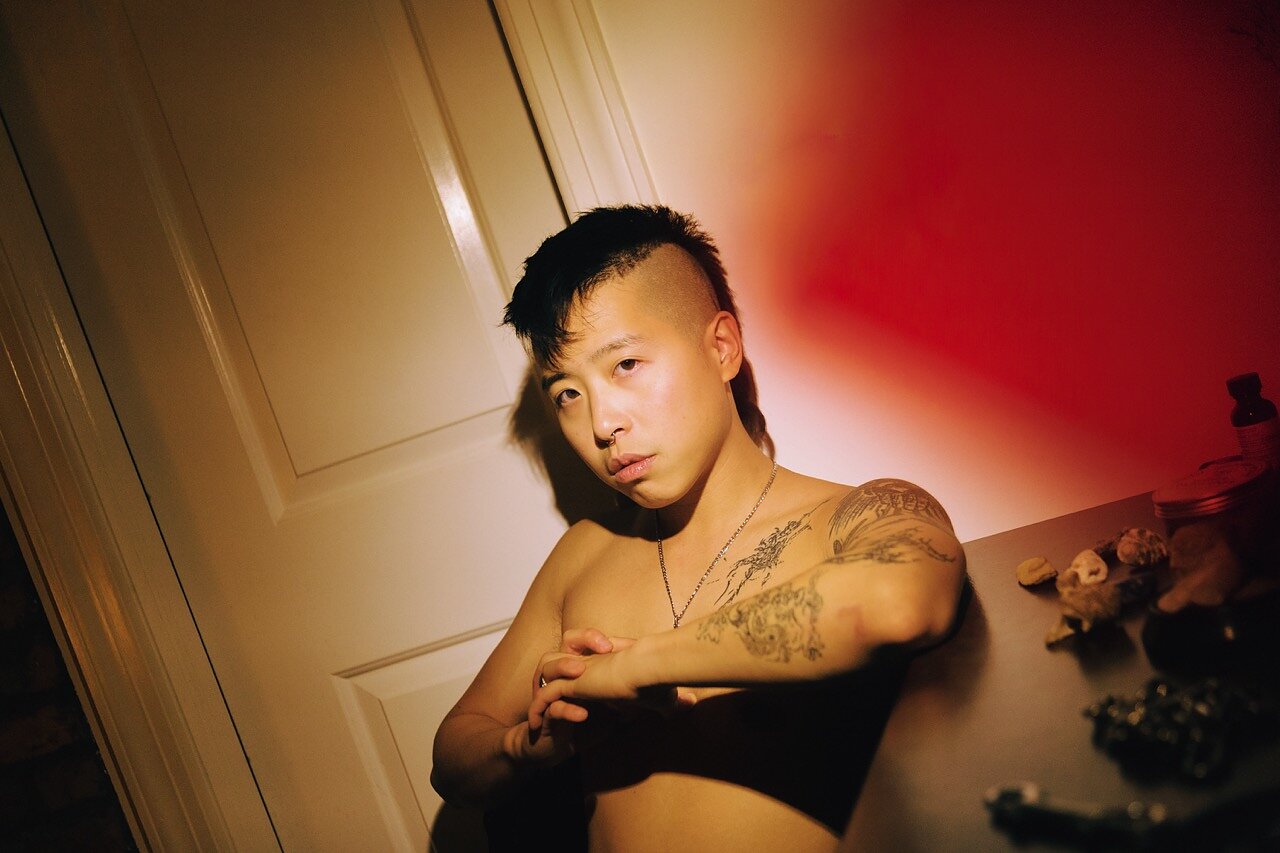Riven Ratanavanh on Subverting Racialized Power Dynamics
CW: Explicit sexual content and nudity.
While much has been written about the racialized and gendered constraints placed on Asian bodies, few mediums can confront the subject of fetishization as directly and viscerally as performance art. In this space, the body becomes both a historical artifact and an active subject repeatedly reproduced by the audience’s gaze.
Riven Ratanavanh’s practice consistently navigates these constraints, yet always finding openings, elasticity, and catharsis within them. I first met Ratanavanh at a class called “Sex Ed” at the School for Poetic Computation. We started following each other’s work thereafter, drawn to the way we mutually excavate and push our cultural and gender identities.
A pivotal work of theirs is Interior Scroll, which was performed as part of Movement Research at Judson Memorial Church earlier this year. Clad in leather and metal, Riven led a white man—naked, save a hood and chastity belt—on all fours out on stage in a slow, deliberate procession somehow befitting while also completely clashing with the ceremonial air of the venue. Inspired by a famous 1975 performance of the same name by Carolee Schneemann, Ratanavanh took out a small paper scroll of poetry, read from it, and inserted it into the white man’s ass through a hollow buttplug. Those familiar with the canons of performance art nodded surely to the many references, reversals, and subversions in the piece while others seemed dazzled or confused.
I was struck by how this piece marked a dramatic shift in their practice—from focusing on the interiority of an Asian, transmasculine body to foregrounding and subverting power dynamics, both racially and erotically. In the meditative space of their home studio, Riven and I sat down to discuss the complexities of embodying Asianness and transmasculinity in their work.
Riven Ratanavanh: I’m thinking back to the conversation we had in the park last summer when I was still developing my piece for the Judson Center. That conversation really played a part in shaping the work in many ways.
I think my practice has changed a lot since that piece. I’ve been thinking a lot about my identity, my transness and queerness for many years, but it wasn’t until this more recent work that I’ve been able to find an entry point to explore the added layer of being an immigrant and East/Southeast Asian.
RR: I encountered Schneemann’s work early on in the first performance art/experimental dance class I ever took. I did have some exposure to the performance world before moving to New York from Thailand but learning about Schneemann was definitely part of my learning more about the legacy of experimental performance in New York which has shaped so much of what’s happening today.
The reason this piece came up now was because I was feeling quite rageful, particularly about all the subtle and explicit ways I was experiencing racism, specifically the ways they were veiled in desire and racial fetishization, and also the ways they were coming up in conjunction with my experiences being trans. Previously my work was only mostly focused on the dimension of gender identity, but now I’m seeing that I can’t address trans issues—the way I’ve experienced and navigated them—without also addressing race because they’re very intertwined.
With the Schneemann piece, I think I was quite frustrated seeing this cis white woman expressing her anger and realizing that I didn’t have many reference points for how I should or could express my anger—especially when, culturally, I wasn’t taught how to do that.
I was raised as a girl for the first 18 years of my life in Thailand, where social norms are still very paternalistic relative to the US, and that does shape how I move through the world and what I’ve been taught about what I’m allowed to express or not. I was looking for ways I could honor and express something about these wrongs I’ve experienced.
RR: You have to say it straight! Experiencing these veiled racist comments takes me such a long time to process, and I’m sure it’s similar for anyone else who has experienced these kinds of racialized power dynamics. It can so often make you question yourself: Is that what really happened? Do I have a right to be angry? Do I have a right to say something about it?
It’s important to acknowledge that these things are real. There’s no beating around the bush. In that, I hope the work is validating for folks who have had similar experiences—that what they experience is real and that it warrants, can warrant a response like this.
BH: For your Movement Research series at the Judson Memorial Church, you took out a scroll of poetry that you rolled up and put in the ass of an anonymous kneeling white man in a chastity cage.
I remember the air felt very still, like everyone was holding their breath. I could sense how folks who have experienced the kinds of racialized power dynamics you were describing felt a kind of catharsis through that series of actions.
I know there was a whole thing about how you found the performer who agreed to take part in this work that really speaks to the complications of racialized desire.
RR: Racialized desire is something I’ve experienced in different ways growing up in Thailand and also here. It’s taken me so long to unpack; I’m still unpacking it.
The thing about the performer… well, I had interviewed a few candidates. One of them was a cis white gay sub who could have been a good fit but wasn’t available for the show date. The other was a closetedly kinky ‘straight’ man who had come to me through a prodomme friend who helped put out a call for performers. He would have been a great fit but the only problem was he was married and had been cheating on his wife. Shortly after I interviewed him he wrote back to me to come clean and say he had to reconsider his personal decisions—which likely saved me, in some way.
So what ended up happening was a good friend’s partner who is transfeminine heard I was working on the piece and thought it could be fun and liberating to anonymously portray a man on stage. It was funny—t4t (trans for trans) saved the day. Really, the whole thing was a gag.
But in performances I’ve done since involving white submissives, those have been with actual cis-identifying white men who maintain relatively serious submissive lifestyles.
RR: The way racism gets coded in desire and sexual power dynamics is through this flattened gaze that can only see you through a lens of particular stereotypes.
When it comes to the audience’s gaze, I’ve been thinking about the predominantly white space of the performance art world. A lot of the lineages of performance art (ie: Schneemann’s work) attest to this. On the one hand, I’m making work that I want people in my queer, trans, Asian diasporic communities to see. On the other, I’m thinking about how I would say this and place it within a quite white performance art world.
Working on this piece, I did anticipate the audience to be quite white and so wanted to be very very legible to that audience. I think that’s why to a degree it’s quite loud and a bit of a “fuck you.” But even then, I don’t know if they’re even listening. Maybe they’re still looking at me on stage still perceiving whatever they perceived before; I can’t control that.
Moving to America was important to me for teasing out and coming to better understand racialized power dynamics and the ways it intersects with gender. I started transitioning after moving here, so I’ve experienced racialized gendered stereotypes and how they play out on both ends of the gender spectrum in America. I grew up with similar yet different racial dynamics in Thailand due to cultural imperialism but I didn’t have as much of an ability to recognize these dynamics until I moved to the US. It’s also the scholarship and conversations happening here that have deepened my understanding.
Something about getting to shape the rules of engagement is very empowering. And it is a choice to engage, because as much as I present an objectification on stage, behind the scenes it remains interpersonal. It can be very revealing and continues to teach me about navigating power differences.
RR: Right. The power dynamics in my work (so far) are the flip of what happens in Slave Play, because I’m staging the inverse of a colonial dynamic.
Slave Play informed my thinking a lot. I’d love to see a play like that for Asian Americans/Asian diasporic identities.
Coming up, I’d like to make work where I’m not necessarily portraying myself in a dominant role. I think I’ve already nailed that point in (though who knows, maybe it can’t be nailed in enough?) and there will be more to explore with the inverse.
RR: That piece began with my frustration in navigating the medical system here in New York to get my testosterone. The piece was hung up in a gallery with a placard next to it that said, “Please do not touch the work unless you identify as trans or gender non-conforming.” The piece itself looks like a blank canvas but has topical testosterone on it. Topical testosterone gets absorbed through the skin so by touching the work, you are absorbing it receiving this treatment.
I wanted to create this statement of self sovereignty. So much of gender affirming care is medically gatekept. Testosterone is a controlled substance because it’s abused by cis white men who use it as a steroid substitute. Even though I had a prescription for it, it was so hard for me to actually get access because it’s so controlled through different bureaucracies.
Most days I just marvel at how, if I keep putting this clear substance that looks like nothing onto my armpits for long enough, the world will treat me differently. I mean, isn’t it crazy? I think that’s also why it was important to put it on a blank canvas. It’s in portrait orientation which kind of evokes a mirror or something waiting to be filled in, and I found that viewers would project all sorts of meaning onto it depending on their identities and positionalities.
BH: The inaccessibility of gender affirming care and the care that you embedded in this piece for queer and trans audiences speak directly to one another. I wanted to talk about some earlier works that you’ve done. I’ve noticed a throughline of pulling the interior out into the exterior. That’s obviously quite literal in your interpretation of Interior Scroll but you tend to use technically apparatuses to basically draw out your insides.
In Inner Dawn (2022), you connected your pulse to animate a light that illuminated your body. In other works, you’ve used microphones and transducers to amplify the sound of your breath.
RR: That’s a really great point! I feel very seen. I think that’s where my artistic practice really started. A lot of it comes from my understanding of my transness and my journey through that. Coming into myself has felt like going to my interior and asking what I want to bring out to shape how I am embodied in the world and move through/with it.
That ties into my background in movement. There’s an international image of Thailand as having a lot of trans representation but growing up there, I didn’t know being transmasculine was a possibility until I was 18 or 19. I didn’t see trans masculinity except for one or two white trans men on the internet so for some reason I just thought it was impossible–that I was impossible. I didn’t think the gender affirming care I needed even existed – nonetheless think about accessing it – so it led me to try to figure out what I could do to shape my body through physical practice. That felt like the only way forward for me. That’s how I came to movement/dance, and then by way of that, to performance more broadly.
Working with the body and performance has invariably posited me at the intersections of race and transness. In both instances, the subjected body gets flattened and denied interiority. You have to assert your sovereignty to be who you are, rather than what the world prescribes you to be.



